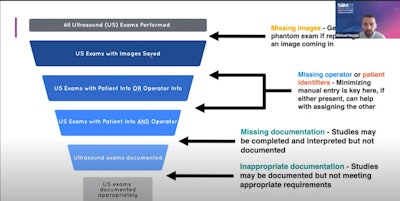
KISSIMMEE, FL - Point-of-care ultrasound's (POCUS) place in practices depends on how it's implemented into emergency medicine clinical workflows, according to a presentation given June 9 at the Society for Imaging Informatics (SIIM) annual meeting.
Emergency medicine panelists discussed how their respective practices adapted their workflows to fit POCUS in while ensuring compliance.
"We have a difficult job as emergency docs, and we can make that a whole lot harder by using a specific type of workflow and tools," said Dr. Elias Jaffa from Prisma Health Upstate in South Carolina and panel moderator. "And we can make it easier for docs by giving them the correct tools and dropping barriers to doing things the right way."
POCUS can be applied to various medical settings, including emergency medicine, primary care, and intensive care. Previous research shows that along with portability, POCUS is feasible to use and cost-effective. The researchers also tout its ability to provide focused imaging for particular regions, real-time image capture, and repeatability, among other advantages.
However, when it comes to traditional emergency medicine workflows and credentials, POCUS may seem like a square peg in a round hole. In the SIIM session, researchers went over how their respective practices improved in efficiency after making workflow changes.
Order-based vs. encounter-based workflow
Two types of workflows are recognized in medical settings: order-based and encounter-based. Order-based workflow is structured and implies preplanning or intentional image capture. Clinicians write orders for a patient to be imaged and from there, radiologists interpret images and clinicians discuss results with patients.
Encounter-based workflow, meanwhile, implies that images will be captured on the fly. Here, clinicians can take images and consult with specialists before discussing results with patients.
While flexible, researchers said encounter-based workflows present their own set of challenges. These include simultaneous image acquisition and interpretation, multiple studies per patient, a wide range of clinical training and expertise, variable credentialing strategies, and emerging technologies.
Erica Peethumnongsin, PhD, from Duke University Hospital and one of the panelists at the presentation, said the hospital overhauled its ultrasound workflow to be encounter-based. She said the clinic had problems with its previous order-based workflow.
"Because of some of the problems we had with losing scans ... or hanging orders, it made for a lot of administrative problems," Peethumnongsin said.
She added that while a lot of "heavy lifting" was needed when working with administration and information technology staff, the encounter-based workflow is up and running.
Fellow panelist Dr. Michael Macias from Temecula Valley Hospital in California also said the hospital recently switched to encounter-based workflows.
"The reasoning for that workflow was really about capturing our total exams. I think that's always been the issue with POCUS," he said. "We found that the encounter-based workflow was the way to capture the highest end. You actually have accountability to address the problem."
Credentialing: Uniformity vs. granularity
SIIM panelists also discussed how staff should be credentialed in using POCUS, answering the question of whether all staff be credentialed through the same applications or if only some staff should be credentialed with varied applications.
Macias said this depends on the site.
"If I have a small community site, I'm probably going to favor uniformity," he said. "If I had a system-wide program with a bunch of different specialties ... there might be a role for granularity."
Peethumnongsin, meanwhile, said the field will eventually reach a point where "most people" will be uniform in their credentialing.
"But when we look at our colleagues who are still developing uniform guidelines as a specialty, this will be an issue to deal with over the next couple of decades," she said. "I think the key is to be able to adapt to those different levels of credentialing and privileging."
Ensuring compliance
Incomplete POCUS studies are the result of one or a combination of missing factors, including missing operators, documentation, images, and patient identifiers. Phantom scans, meanwhile, are studies that have not been documented into the medical record or have archived images.
 Dr. Michael Macias from Temecula Valley Hospital in California speaks about ensuring compliance for point-of-care ultrasound (POCUS) workflows at the Society for Imaging Informatics in Medicine (SIIM) annual meeting. Macias was part of a panel discussion on adapting workflows for increased and efficient use of POCUS.
Dr. Michael Macias from Temecula Valley Hospital in California speaks about ensuring compliance for point-of-care ultrasound (POCUS) workflows at the Society for Imaging Informatics in Medicine (SIIM) annual meeting. Macias was part of a panel discussion on adapting workflows for increased and efficient use of POCUS.Macias said from an administrative control perspective, radiologists can use middleware solutions to prevent POCUS images from making it to the electronic medical record until other information such as operator information and patient identifiers are filled in. He added that Temecula Valley Hospital achieved a 96% compliance rate out of 2,454 studies created.
"When I'm thinking about compliance, I'm thinking about how I can create a system where when a study enters your workflow, it can be monitored and pushed forward until it's finally complete," Macias said.
"If you make the easy way the right way, then you're all good," Jaffa added.




















